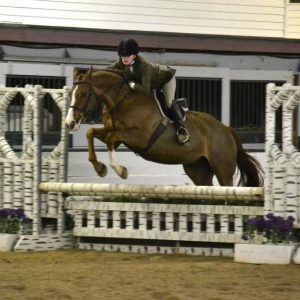Horse Show FAQ
The idea of horse showing can be exciting, and intimidating!
Don’t worry, our professional team of trainers and the experienced members of our show team are always here to help. Here are a few of the questions we get asked most often.
How old do I have to be to compete in a horse show?
Participation is horse shows is determined strictly by ability, and not by age. There are classs for children that involve just walking; walking, trotting, and cantering; and also classes that require jumping over very small obstacles, as low as ground poles or small, 18-inch cross rails. While many students start showing when they are still quite young, many others start as teenagers or even adults.
Am I good enough yet to ride in a show?
There are several different levels at which a rider can begin competing. The earliest is at the walk-trot-canter stage. There are divisions at some horse shows dedicated to those who have not yet learned to jump, and are comprised of classes which are only “on the flat.” These classes are a fun, low-stress way to orient children and adults to the sport of competitive horseback riding. Some riders do not compete until they are ready to perform in jumping classes.
Like any sport, the toughest competitors dedicate a tremendous amount of hours, sweat and tears toward achieving at the highest level. At Palladia Farm, we have very talented riders who compete at a national level, and also more casual riders, who enjoy competing casually, as their schedules and budgets allow. We also have riders who choose not to compete, instead enjoying their horses at home. In summation, the decision to start competing is an individual process, there is no right or wrong answer as the variety of classes enables rides of all skill levels to compete.
![]() How do horse show logistics work?
How do horse show logistics work?
Riders are responsible for providing the horses that they will compete on at a horse show. Before the show, the horses are transported from our barn at home to the show facility in a large trailer that is specially designed for equine use. At the competition grounds, we rent stalls for the horses to stay in for the duration of the show, as well as the extra space that we need to prepare the horses for competition. We usually arrive a day before the competition begins, in order to give the horses some time to settle into the new environment.
What do they judge at a horse show?
Most classes are judged “over fences.” In these classes, the horse and rider jump a set of obstacles in a particular order. A judge evaluates each competitor, and then awards ribbons and prizes to the top performers. The judge’s opinion is subjective, though there are certain guidelines that all judges must follow. In this way, judging at horse shows is similar to the kind of judging you might find at a dog show.
 There are three types of classes at each competition that we attend. The first category is called “hunters” (left). In the hunter division, the horses are judged according to their style, form, and disposition while performing over a course of jumps. The hunter division derives from fox hunting, and maintains a strong association with the hunt. This can be seen in the clothes that the hunters wear, as well as look of the obstacles that they jump and the criteria by which they are judged.
There are three types of classes at each competition that we attend. The first category is called “hunters” (left). In the hunter division, the horses are judged according to their style, form, and disposition while performing over a course of jumps. The hunter division derives from fox hunting, and maintains a strong association with the hunt. This can be seen in the clothes that the hunters wear, as well as look of the obstacles that they jump and the criteria by which they are judged.
Another category of competition is called “stadium jumping” or “show jumping”, often referred to simply as “jumpers” (right). In the jumper division, the judging is 100% objective, as opposed
 to that of the hunter ring. The horse/rider combination that completes a proscribed course the fastest without knocking any obstacles down is the winner. Stadium jumping is the most popular type of equestrian competition across the globe, and is even an Olympic sport.
to that of the hunter ring. The horse/rider combination that completes a proscribed course the fastest without knocking any obstacles down is the winner. Stadium jumping is the most popular type of equestrian competition across the globe, and is even an Olympic sport.
The last area of competition is the only one in which the rider is judged instead of the horse. We call this category “equitation”. Equitation is most popular among junior riders (those 17 years old or younger as of December 1st of the competition year). The equitation division seeks to identify and promote good riding and horsemanship skills, and to challenge the riders’ knowledge base and application thereof.
Do I have to have my own horse in order to compete in a horse show?
Most participants own the horses that they show, but leasing a horse is also common. Most equine leases last several months to a year. At Palladia Farm, however, we often have several competition-quality horses that are sometimes available for short-term leases. Leasing one of our horses is a convenient, low risk way to try out competing in horse shows. As a student becomes more serious about showing, he or she will need to purchase or lease a horse to ride throughout the show season.
What do I need to wear in order to compete?
In equestrian competition, riders wear an outfit that derives from military uniforms, reflecting the origins of horse riding. All riders wear a hunt coat (even in the summer!) that looks much like a man’s blazer. Traditionally, riders wear black, navy, or hunter green coats. In the hunters or equitation, your coat must be one of these colors. Others, such as gray, burgundy, or kelly green are available, but should only be worn in the jumper ring, where riders have a bit more leeway with their attire.
Underneath their coat, men and boys wear dress shirts with a tie. Women wear special show shirts that are similar to ratcatcher shirts, though the style has been modernized within the past ten years. Traditionally, these collars are monogrammed with the rider’s name or initials.
Both men and women wear breeches, which are tailored, elasticized riding pants. Tan or beige are the preferred colors; white is considered to be formal attire in the hunters and equitation, but is commonly seen in the jumper ring. Tall, knee-length, black leather boots (called dress boots or field boots) are worn over the pants.
Children twelve and under may wear jodhpurs, which are longer pants with cuffs at the bottom, and a pair of leather garters worn just below the knee. They wear short boots, called paddock boots (these are the same boots we recommend buying for lessons), underneath the pants, and special straps which attach to the bottom of the jodhpurs and go under the sole of the paddock boot in order to keep the jodhpurs from riding up the leg.
All riders must wear a belt, as well as an ASTM/SEI-approved helmet. All helmets should be covered with black velvet or a newer, symthetic suede-like material. Colored helmets and plastic ones are NOT appropriate for competition. In equitation classes, riders are required to wear gloves. Many riders prefer to ride with gloves, and using them is always permissible. Gloves used in competition should be solid black, without fancy stitching or other adornments.
Lastly, if you are going to be competing in a horse show, you should also bring along a pair of spurs and a crop, in case you need them. When you arrive at the show, you will receive a number that you will wear throughout the competition.
Where are horse shows held?
Everywhere! There are horse shows in every state, and many different countries around the world. There are probably a hundred horse shows held in Illinois every year, most of which are near the greater Chicago area.
Once a rider reaches a certain skill level, he or she may want to travel farther to larger horse shows, in which he/she can compete against the elite horses and riders in the sport. It is not uncommon to travel to Florida or California for shows during the winter, and to Kentucky, Vermont, or Colorado for horse shows during the summer. Many horse show venues are beautifully situated in vacation towns which make a lovely vacation destination for the entire family.
